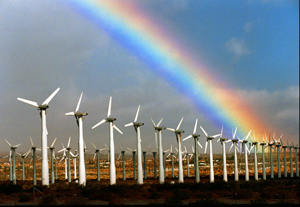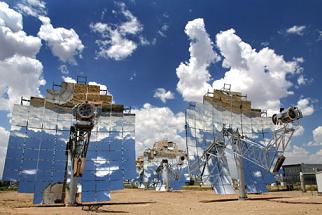 I previously noted that efficiency is essential to eliminating fossil fuel use, because non-fossil sources have an overall market price cost higher than coal, natural gas, and even oil. This is not as obvious as it seems. Up to a point, renewable energy is competitive with fossil fuels; the problem is, that point is never a majority of consumption.
I previously noted that efficiency is essential to eliminating fossil fuel use, because non-fossil sources have an overall market price cost higher than coal, natural gas, and even oil. This is not as obvious as it seems. Up to a point, renewable energy is competitive with fossil fuels; the problem is, that point is never a majority of consumption.
Take electricity.
You can produce unsubsidized wind power at 4 cents per kWh — cheaper than natural gas, cheaper even than “clean” coal. Unfortunately wind (like most renewables) provides variable power. It can be predicted to some extent, but comes on nature’s schedule, not when wanted. That doesn’t matter much as long as it supplies around 20% or less of total demand. Up to that point, the utility can treat it as negative load; added power when the wind slows or stops comes from existing operating and spinning reserves.
Beyond that point, wind energy without storage requires additional capital, additional reserve-generating capacity. That brings the price up steeply. There are regions that have more wind capacity than this, sometimes a great deal more. But they manage it by exporting electricity to other utilities. If you look at the grid as a whole, and not just local sub-grids, you will find no place where wind supplies much more than 20% of consumption in practice — without storage.
There are non-fossil fuel sources that don’t suffer from this problem, but they are limited. Geothermal electricity is reasonably priced and fully dispatchable, but cost-effective world resources are limited with current technology. (Yes, there are nations like Iceland where that is not a problem, but it is true for most of the world.) The same applies to hydroelectricity. Biomass energy is inexpensive when produced from waste, but still more costly than oil when purposely cultivated on energy farms — with serious water consumption, land use, and net energy issues.
In short, you have to add storage, and storage is expensive.
Further, if we are serious about renewable energy — if we want to see a majority of our energy supplied from renewable sources — we will need a lot of storage: days, not hours.
Aren’t there inexpensive means of electricity storage? Yes, but again, they are limited. Pumped storage, wherein water is pumped uphill, can store energy at as low a cost as a tenth of a cent per kWh. And 70% to 80% of the energy put in can be gotten back out. But inexpensive pumped storage requires downhill water sources near large uphill reservoirs — a fairly rare natural occurrence. Completely artificial pumped storage (water towers on steroids) would be expensive and impractical. Large-scale compressed air also requires uncommon natural features.
OK, so let’s look at the most-often-contemplated means of storage: hydrogen. Forget hydrogen pipelines; electricity is a lot less expensive to transport than hydrogen, and suffers lower transmission losses. Let’s look at hydrogen strictly as a storage method — produced from variable electricity, and used to produce dispatchable electricity from dedicated sites.
At current prices, forget fuel cells as well — combined cycle turbines can burn fuel at 60% efficiency for $500 per KW, a point on the price/efficiency curve no commercial fuel cell can match today. Add to this to the 4 cent per kWh electricity cost plus round trip electricity losses, along with $750 per KW electrolyzers, hydrogen storage, and transmission losses. Fully dispatchable wind electricity will end up costing 19 to 20 cents per kWh to make and transmit — compared to 7 cents, if you average comparable costs for the U.S. as a whole.
What about our most extensive electricity source — the sun? At current prices, photovoltaic cells on rooftops won’t work. PV electricity costs about 15 – 20 cents per kWh before storage. A great deal of the storage cost of wind is due to electricity losses. Use 15 cents per kWh PV instead of 4 cents per kWh wind, and your cost rises to 40 or 50 cents per kWh.
 But there is a form of solar electricity that provides a much less expensive dispatchable energy than PV or wind: solar thermal electricity.
But there is a form of solar electricity that provides a much less expensive dispatchable energy than PV or wind: solar thermal electricity.
For example, Stirling Energy uses parabolic dish mirrors to drive Stirling engines, providing energy for around 11 cents per kWh. They key is that heat is less expensive to store than electricity. A solar thermal farm could add additional mirrors and store the extra heat in molten salts, which the generators could tap at night or during periods of low sun. Such storage is estimate to run around $35 per thermal equivalent of a kWh. After you count storage losses and the cost of additional parabolic mirrors, the cost should run around $0.15 per kWh.
Such thermal electricity has another limitation: you can’t concentrate indirect light. It works only on sunny days. That’s why solar thermal electricity is generated almost entirely in deserts. Fortunately, the limits of electricity are about 5,000 kilometers, and most people on the planet live within that distance of a desert. There is no physical reason lines could not be constructed to allow, say, London to buy solar thermal electricity from Libya — though that’s probably not the most desirable source from a political standpoint.
Note that a breakthrough that produces inexpensive photovoltaic cells won’t solve this problem. All that would do is let you produce solar hydrogen storage for the same 19 or 20 cents per kWh wind hydrogen would cost.
This makes it clear why efficiency is so important. We have the technical capability to generate as much reliable, convenient, fully dispatchable solar- and wind-based electricity as we need. But the costs of generation are expensive — between 2 and 3 times comparable costs for fossil fuels. Total costs don’t need to be that high, because we can factor in some inexpensive variable renewables, along with small amounts of geothermal and possibly hydro. But absent storage breakthroughs, we are going to have pay at least double our current per kWh cost if electricity is to come from renewables.
If the cost of producing electricity is to double or more, we need to triple the efficiency with which we use it. (Triple rather than double, because improving efficiency also costs money.) As I keep stealing from Amory Lovins, what we want from energy is warm toes and cold beer. If we can get more use out of each unit of energy, we can buyer fewer units of that more expensive power — and still do the same things. So the per kWh cost of electricity would double, but our use of electricity would (unnoticeably) drop. Our electric bills would stay the same.
One last point. If efficiency is so much less expensive than new sources, why add new sources at all until efficiency opportunities are completely exhausted? The problem is one of opportunity cost. Some efficiency improvements, such as insulation upgrades, can be added at any time. But most efficiency improvements are only cheaper if implemented as existing infrastructure wears out. It is expensive to throw away a perfectly good pumping system in a factory with ten years of life remaining. It is very cheap, if you are doing a re-pipe anyway, to put in fatter pipes and smaller pumps; this reduces friction, the energy costs of pumping, but only pays for itself because you save money on the cost of the new pumps. It is expensive to replace a new inexpensive window with an expensive one. It is very inexpensive when replacing a worn-out window to put in an efficient rather than inefficient one.
It is thus essential not to avoidably amortize infrastructure prematurely; doing so would multiply the cost of efficiency increases. Similarly, it is essential not to miss any cost-effective chances for efficiency upgrades during infrastructure replacement or upgrade. Each opportunity missed either delays such improvement by at least a decade or multiplies the cost of increasing efficiency by many times.
If we are not going to upgrade our efficiency structure all at once, or even over a short period of time, it is essential not to miss opportunities to upgrade energy sources as well as energy sinks. At the beginning, we should make sure to put in place renewable sources that are cheaper than fossil fuels — variable wind, solar thermal for low temperature use (such as water and space heating), up to a 65% of consumption (more if solar district heating proves out) use of waste biomass, and so forth. As efficiency improvements are put in place, we need to phase in other renewable sources that are competitive with what fossil fuels would have cost if the efficiency was not put in place.
In other words, as we phase in efficiency, we need to make the decision as a society to use that savings to phase in low-carbon sources, rather than continuing to buy comparatively cheap fossil fuels.
Efficiency is the key. Efficiency is what can pay for comparatively expensive dispatchable wind and solar electricity. If solar district heating (or other breakthroughs such as storage in natural zeolites) do not prove cheaper than fossil fuels, efficiency is what will enable us to use low temperature solar thermal to provide more than 65% of climate control and hot water needs.
 I previously noted that
I previously noted that 

